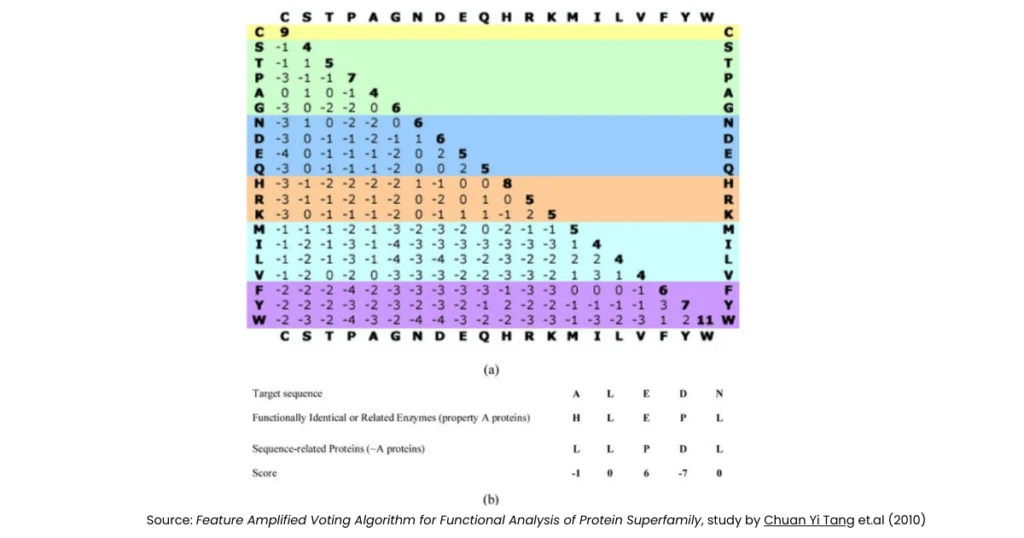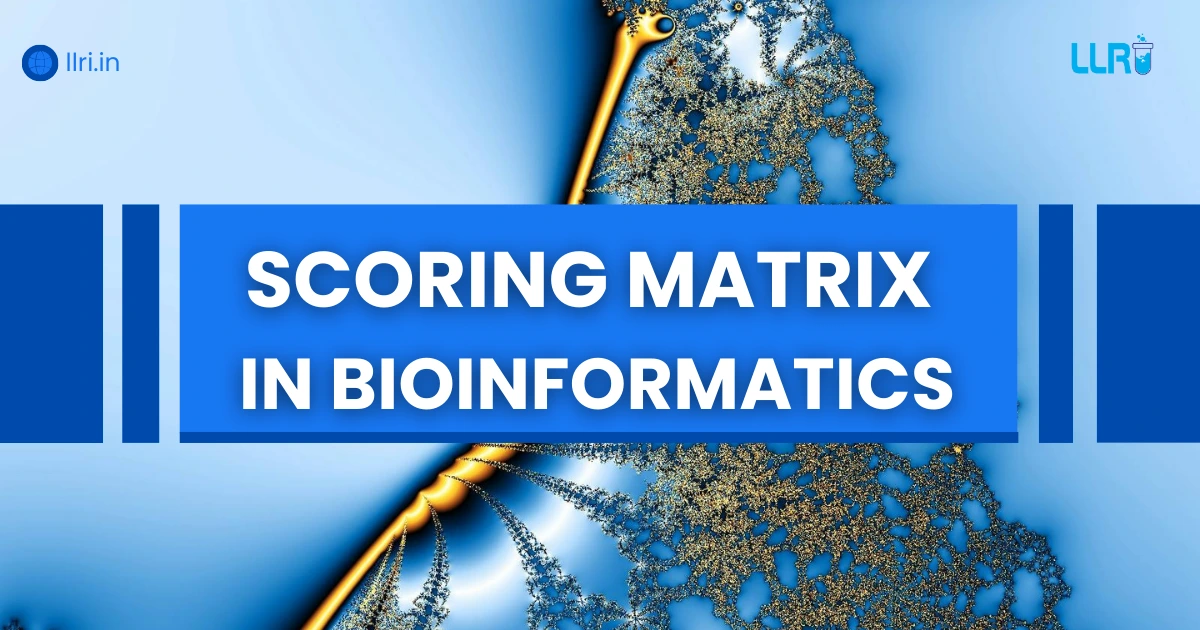Scoring Matrix in Bioinformatics: Nope, we are not talking about Neo from the Matrix movies – sorry to spoil the fun!
Have you ever wondered how scientists compare DNA or protein sequences and decide whether two sequences are related? The secret lies in something called a scoring matrix in bioinformatics. It’s not just a technical term, it’s the very foundation of sequence alignment, which helps researchers discover evolutionary links, detect mutations, and even predict protein functions.
When students first come across this term, one of the most common questions is, “What is scoring matrix in bioinformatics, and why does it matter?” In simple words, it’s a table of values used to score the alignment between biological sequences.
The idea is pretty straightforward: every time two nucleotides or amino acids are compared, the matrix assigns a score that indicates how well they match or mismatch.

What is Scoring Matrix in Bioinformatics?
Let’s start with the burning question: what is scoring matrix in bioinformatics?
A scoring matrix in bioinformatics is essentially a numerical table that helps in comparing biological sequences like DNA, RNA, or proteins. Each row and column in the matrix represents a possible nucleotide or amino acid, and the cells carry a value that represents the score for aligning one character with another.
For example:
- A match (say, adenine with adenine) gets a positive score.
- A mismatch (adenine with cytosine) may get a negative score.
- Gaps, which represent insertions or deletions, also have penalties.
This scoring system is crucial because biological sequences are not always identical, yet they may still carry meaningful similarities. As the well-known bioinformatician David Mount once noted, “Without a scoring system, sequence alignment would be nothing more than random matching.”
Read More: Top Bioinformatics Institute in India
Why Do We Need Scoring Matrices?
Here’s a quick thought experiment: Imagine trying to compare two paragraphs written in slightly different dialects of the same language. You’ll notice that many words overlap, but others differ slightly.
To judge whether the paragraphs are related, you’d assign scores to words that match and maybe penalties to those that don’t. That’s exactly what a scoring matrix in bioinformatics does for sequences.
It helps researchers:
- Detect evolutionary relationships between species.
- Identify functional regions in genes or proteins.
- Highlight mutations and variations.
- Improve accuracy in database searches like BLAST.
In short, scoring matrix sequence alignment is the backbone of bioinformatics analysis. Without it, aligning sequences would lack structure and meaning.
Types of Scoring Matrices
When talking about scoring matrix in sequence alignment, two types dominate the field: PAM (Point Accepted Mutation) and BLOSUM (Blocks Substitution Matrix).
- PAM Matrix
- Based on evolutionary changes observed in closely related proteins.
- Useful when aligning sequences that are evolutionarily close.
- Example: PAM250 is often used for distant relationships.
- BLOSUM Matrix
- Constructed from observed substitutions in conserved regions of proteins.
- Suitable for finding both close and distant relationships.
- Example: BLOSUM62 is the default for BLAST searches.
Both are widely used, and the choice depends on the type of biological question being asked.

Position Specific Scoring Matrix Example
Now, let’s make this more concrete with a position specific scoring matrix example.
A Position Specific Scoring Matrix (PSSM) is slightly different from a general scoring matrix. Instead of giving one score for each substitution across the entire sequence, it considers each position separately.
For instance, imagine you have a protein motif where:
- Position 1 prefers alanine (A).
- Position 2 often has glycine (G).
- Position 3 rarely contains proline (P).
The PSSM will assign higher scores for substitutions that match these tendencies and lower scores where mismatches occur.
This is particularly useful in motif finding, regulatory element detection, and in tools like PSI-BLAST, which build PSSMs to refine searches iteratively.
A real-world position specific scoring matrix example would show probabilities of amino acids at each position in a DNA-binding protein motif, making it easier to detect similar motifs across large genomes.
Scoring Matrix Sequence Alignment in Action
When you align two sequences, every pair of characters compared is scored using the matrix. The total alignment score determines how good the alignment is.
For example, if you’re aligning:
Sequence 1: A T G C Sequence 2: A T A CUsing a scoring matrix in bioinformatics, you’ll assign:
- Match (A-A, T-T, C-C) = positive scores.
- Mismatch (G-A) = negative score.
This simple calculation is what makes scoring matrix sequence alignment effective in real-world applications like gene annotation, phylogenetic analysis, and disease mutation studies.
How to Create a Scoring Matrix in Excel
Now, let’s get practical. Students often ask, “How to create a scoring matrix in Excel?” The good news is, it’s easier than it sounds.
Here’s a simple step-by-step:
- Set up your rows and columns
- List amino acids (or nucleotides) across the top and side.
- Assign scores
- Fill in values for matches (positive), mismatches (negative), and gaps.
- Use formulas for calculations
- Excel’s conditional formatting or IF formulas can help automate scoring.
- Visualise with colour
- Heat maps in Excel make it easier to see which substitutions are favourable.
This method isn’t just for students. Even researchers use Excel for quick simulations before moving to specialised software. Creating a matrix manually deepens understanding of what is scoring matrix in bioinformatics and its application.

Challenges in Using Scoring Matrices
While they’re powerful, scoring matrices aren’t perfect. Some challenges include:
- Choosing the right matrix for the dataset (PAM vs BLOSUM).
- Accounting for evolutionary distances accurately.
- Adjusting gap penalties.
- Handling very large datasets where computational complexity increases.
Still, as one research article in Nucleic Acids Research puts it, “The careful choice of a scoring matrix can dramatically improve alignment accuracy and biological relevance.”
On A Final Note…
So, now that you’ve travelled through the world of scoring matrices, let’s bring it all together.
- A scoring matrix in bioinformatics is the cornerstone of sequence alignment.
- Understanding what is scoring matrix in bioinformatics gives you the foundation to explore deeper research.
- A position specific scoring matrix example shows how nuanced scoring can get at the level of each sequence position.
- Scoring matrix sequence alignment is the method that translates these numbers into meaningful biological insights.
- And yes, you can even learn how to create a scoring matrix in Excel to build intuition.
As a bioinformatics student or researcher in India, mastering these concepts isn’t just academic, it’s a practical tool for exploring everything from disease markers to evolutionary biology.
FAQs
Q1: What is scoring matrix in bioinformatics, in layman’s terms?
It’s like a scoreboard that tells you how well two DNA or protein sequences match.
Q2: Why use a position specific scoring matrix example instead of a general one?
Because biological preferences vary at each position, especially in motifs and conserved regions.
Q3: How does scoring matrix sequence alignment help research?
It reveals relationships between sequences, predicts functions, and highlights mutations.
Q4: Can I learn how to create a scoring matrix in Excel as a beginner?
Yes, Excel is a great starting point for visualising and experimenting with scoring matrices.
Q5: Is scoring matrix in sequence alignment always accurate?
Not always, results depend on the chosen matrix and quality of data.

